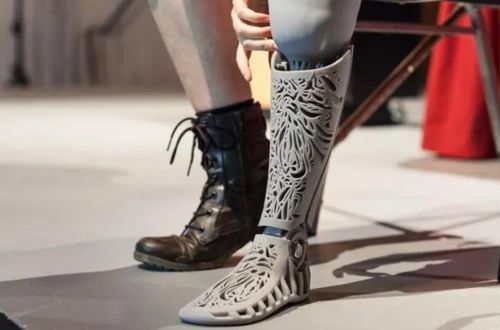

The next decade will likely determine whether 3D printing becomes as essential to medicine as imaging or laparoscopy. Success will depend on scaling production without sacrificing customization.

By Matthew A. McIntosh
Public Historian
Brewminate
The Shift from Prototype to Patient Care
For years, 3D printing occupied a niche corner of manufacturing, producing prototypes and experimental designs. In health care, it has quietly moved from laboratory curiosity to a technology with tangible clinical impact. Surgeons are using 3D printed anatomical models to plan complex operations. Orthopedic specialists are implanting custom-printed joint replacements. Prosthetics labs are delivering affordable, tailored limbs to patients who might otherwise wait months or years for a fit.
The technology’s appeal is straightforward: it enables highly customized solutions, produced quickly, at a cost that is falling as printers become more common. In medicine, where each body presents unique dimensions, this adaptability is more than a convenience. It offers a way to match treatment precisely to anatomy, reducing complication rates and improving recovery times.
The Scope of What Can Be Printed
While 3D printing in medicine began with rigid plastics and metals, its frontier now includes flexible polymers, resorbable materials, and even living cells. Titanium joint implants can be designed to fit the patient’s bone geometry exactly, while dissolvable airway stents can be printed to match a child’s trachea and then naturally degrade as the patient grows.
Perhaps the most provocative work is in bioprinting, layer-by-layer fabrication of living tissue. Researchers have already printed simple structures such as skin grafts and cartilage. More complex organs remain in early stages, but the idea of creating transplantable tissue from a patient’s own cells has moved from speculative fiction to a plausible scientific target. If realized, it could reduce reliance on organ donation lists and eliminate rejection risks.
Case Studies and Current Use
At the Mayo Clinic, surgeons preparing for facial reconstruction can hold a 3D printed replica of the patient’s skull, plan their incisions, and even rehearse bone graft placement. In the United Kingdom, National Health Service hospitals have reported faster operating times in orthopedic cases when 3D printed guides are used, saving both patient stress and public funds.
In low-resource settings, nonprofits have deployed 3D printers to produce prosthetic limbs on-site. Instead of waiting for centralized manufacturing, a local technician can scan, design, and print a prosthesis in days. For children, whose bodies change quickly, this speed and affordability can be life-altering.
Economic and Regulatory Hurdles
The promise of 3D printing in health care is tempered by the complexity of bringing any new medical device to market. Regulatory bodies require evidence of safety and effectiveness, particularly when printed objects will be implanted. Unlike mass-produced devices, 3D printed solutions are often one-of-a-kind, raising questions about how to standardize approval processes.
There are also cost considerations. While the price of printers and materials is dropping, high-end medical-grade systems remain expensive. Hospitals must decide whether the investment will deliver savings through reduced surgery times, shorter hospital stays, or fewer revision surgeries. Smaller clinics may struggle to justify the upfront cost without access to shared or centralized printing facilities.
Ethical Dimensions and the Risk of Inequality
As with many technological advances, 3D printing risks widening existing disparities in health care. Advanced printing labs are clustered in research hospitals and private clinics with substantial resources. Patients in rural or underserved regions may have to travel long distances to access these services.
There is also a philosophical question: if the ability to print replacement parts for the body becomes commonplace, how will that shape our concept of repair, disability, and even mortality? For now, these remain speculative concerns, but they lurk in the background as the technology advances.
The Road Ahead
The next decade will likely determine whether 3D printing becomes as essential to medicine as imaging or laparoscopy. Success will depend on scaling production without sacrificing customization, navigating regulatory frameworks built for mass manufacturing, and ensuring equitable access.
For the patients already benefiting, the technology’s impact is immediate and personal, a hip joint that fits perfectly, a surgical plan executed with millimeter accuracy, a prosthetic hand designed for both function and aesthetics. For the health care system, the question is not whether 3D printing can work, but how to integrate it so its promise does not remain confined to a few well-funded centers. In the quiet hum of a printer laying down its next layer, the future of medical care is taking shape, not in abstract theory, but in tangible form, one layer at a time.
Originally published by Brewminate, 08.19.2025, under the terms of a Creative Commons Attribution-NonCommercial-NoDerivatives 4.0 International license.


